https://github.com/shutterstock/juxtaposer
Screen shot capture and comparison tool for testing website changes.
https://github.com/shutterstock/juxtaposer
capture image image-capture images screenshot screenshots
Last synced: 3 months ago
JSON representation
Screen shot capture and comparison tool for testing website changes.
- Host: GitHub
- URL: https://github.com/shutterstock/juxtaposer
- Owner: shutterstock
- License: mit
- Created: 2014-05-12T17:12:05.000Z (over 11 years ago)
- Default Branch: master
- Last Pushed: 2020-07-15T19:42:36.000Z (about 5 years ago)
- Last Synced: 2025-04-13T11:52:17.606Z (6 months ago)
- Topics: capture, image, image-capture, images, screenshot, screenshots
- Language: JavaScript
- Size: 436 KB
- Stars: 14
- Watchers: 40
- Forks: 2
- Open Issues: 11
-
Metadata Files:
- Readme: README.md
- Contributing: CONTRIBUTING.md
- License: LICENSE
- Code of conduct: CODE_OF_CONDUCT.md
Awesome Lists containing this project
README
# juxtaposer
[](https://codeclimate.com/github/shutterstock/juxtaposer)
[](https://david-dm.org/shutterstock/juxtaposer)
[](https://david-dm.org/shutterstock/juxtaposer#info=devDependencies)
[](https://waffle.io/shutterstock/juxtaposer)
[](https://waffle.io/shutterstock/juxtaposer)
> Screen shot capture and comparison tool for testing website changes.
## Table of Contents
- [Install](#install)
- [Global Install](#global-install)
- [Project Install:](#project-install)
- [Example project](#example-project)
- [Getting Started](#getting-started)
- [Examples](#examples)
- [Basic Example](#basic-example)
- [advanced example](#advanced-example)
- [Environment translations](#environment-translations)
- [Custom report templates](#custom-report-templates)
- [Difference Image Types](#difference-image-types)
- [Targets](#targets)
- [config file settings](#config-file-settings)
- [command line flags](#command-line-flags)
- [Flow](#flow)
- [Contribute](#contribute)
- [License](#license)
## Install
### Global Install
`npm install -g juxtaposer`
### Project Install:
`npm install --save-dev juxtaposer`
When installed for a single project, the binary is `./node_module/.bin/juxtaposer`
## Example project
There is a [sample project in the repo](https://github.com/shutterstock/juxtaposer/tree/master/example). To run the sample app:
* Clone the repo.
* In the `example` folder, run `npm install`
* Start the express server: `./bin/www`
* Run juxtaposer: `./node_modules/.bin/jux`
You should see output very similar to the image below:
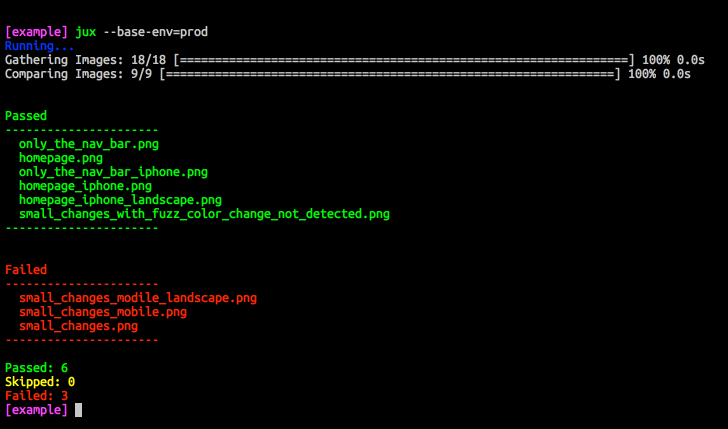
If you run `juxtaposer` with the `--report` flag, you will see the html report:

## Getting Started
**Step 1** Make a file in the root of your project called `juxtaposer.json` with the contents:
#### juxtaposer.json
```json
{
"imagesDir": "test_images",
"substitutions": {
"prod": {
"query": "production"
},
"dev": {
"query": "development"
}
}
}
```
**Step 2** Make a file in the root of your project called `targets.json` with the contents:
#### targets.json
```json
[
{
"name": "sample_query.png",
"url": "https://www.google.com/#q={{query}}"
}
]
```
**Step 3** Run `juxtaposer --report`
**Step 4** Customize `juxtaposer.json` and `targets.json`
## Examples
### Basic Example
Create your config file:
#### juxtaposer.json
```json
{
"imagesDir": "my_images",
"substitutions": {
"prod": {
"subdomain": "www",
"test_env": ""
},
"dev": {
"subdomain": "testing",
"test_env": "development."
}
}
}
```
Specify the targets:
#### targets.json
```json
[
{
"name": "photo_homepage.png",
"url": "http://{{subdomain}}.{{test_env}}example.com/login"
}
]
```
When you run the command `$ juxtaposer`, it will store the url `http://www.example.com/login` at `my_images/baselines/photo_homepage.png` and the url `http://testing.development.example.com/login` at `my_images/samples/photo_homepage.png` and then the two images are compared.
### advanced example
#### juxtaposer.json
```json
{
"showReport": true,
"export": true,
"targetEnv": "staging",
"baselineEnv": "production",
"substitutions": {
"production": {
"subdomain": "www"
},
"staging": {
"subdomain": "staging"
}
}
}
```
#### targets.json
```json
[
{
"name": "excluding_two_regions.png",
"url": "http://{{subdomain}}.example.com",
"exclude": [ ".stats_section", "#user-info" ]
},
{
"name": "only_the_given_coordinates.png",
"url": "http://{{subdomain}}.example.com",
"only": [200, 0, 960, 50]
},
{
"name": "only_the_content_div.png",
"url": "http://{{subdomain}}.example.com",
"only": "#content"
},
{
"name": "narrow_view.png",
"url": "http://{{subdomain}}.example.com",
"width": 350
}
]
```
## Environment translations
The substitution values in the config file are used to build the url. It uses the swig template engine to build the urls. Example:
For the url `http://{{subdomain}}.{{test_env}}example.com`
And the substitutions:
```json
"substitutions": {
"prod": {
"subdomain": "www",
"test_env": ""
},
"qa": {
"subdomain": "testing",
"test_env": "qa."
},
"dev": {
"subdomain": "testing",
"test_env": "development."
}
}
```
Will generate the following domains:
* `prod`: `http://www.example.com`
* `qa`: `http://testing.qa.example.com`
* `dev`: `http://testing.development.example.com`
*Note:* `test_env` for both `qa` and `dev` in this example have trailing `.`.
## Custom report templates
You can specify your own report template for the html report using the command line flag `--report-template` or with `reportTemplate` in the config file. The report template is rendered with the [swig template language](https://paularmstrong.github.io/swig/)
The following information will be passed to the template:
```json
{
"settings": {
"ranAt": "Tue, 06 May 2014 03:23:28 GMT", // timestamp when the tests ran
"isBaselineNeeded": false, // true if the baseline images were captured on this run
"baselineEnv": "prod", // baseline environment
"targetEnv": "dev", // target environment
"cwd": "/Users/user/code" // directory where the test ran
},
"tests": {
"failed": [
{
"prettyName": "home page",
"imageName": "home_page.png",
"baselinePath": "baselines/home_page.png",
"samplePath": "samples/home_page.png",
"diffsPath": "diffs/home_page.png",
"compositeImage": "diffs/home_page.comp.png",
"changesImage": "diffs/home_page.changes.png",
"animateImage": "diffs/home_page.animated.gif"
},
{
//...
}
],
"skipped": [
{
//...
}
]
"success": [
{
"prettyName": "google homepage",
"imageName": "google_homepage.png",
"baselinePath": "baselines/google_homepage.png",
"samplePath": "samples/google_homepage.png",
"diffsPath": "diffs/google_homepage.png"
}
]
}
}
```
## Difference Image Types
### Changes View
The changes pixels overlayed on the dimmed version of the baseline image.
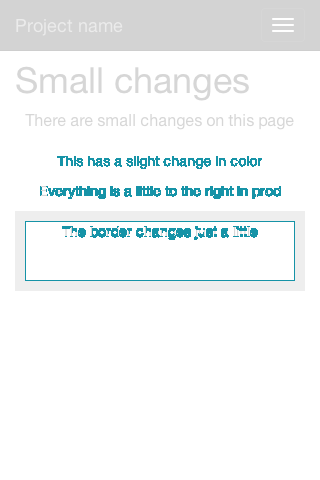
### Animated View
A gif that switches between the baseline and the sample image.
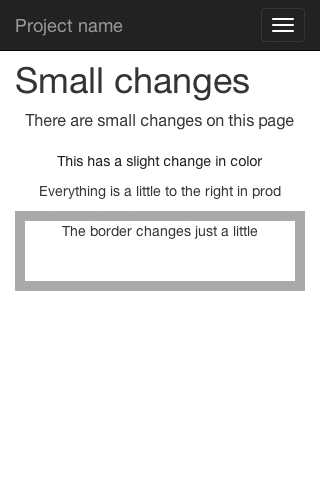
### Composite View
The negative view of the changed pixels.
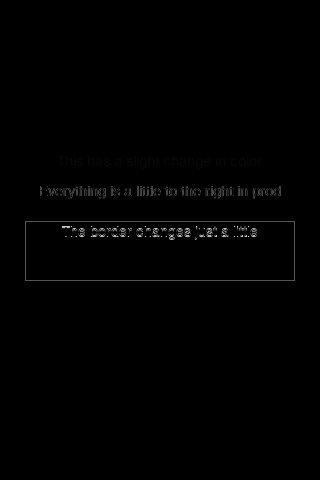
### Diff View
Only the changed pixels on a white background.
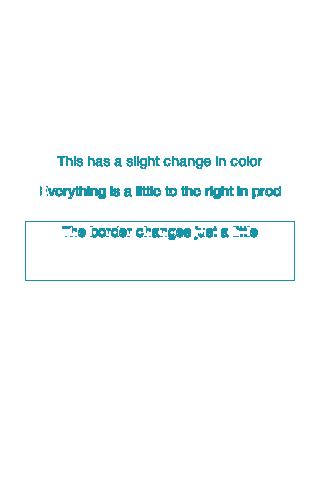
## Targets
The `targets.json` file is a list of urls you want to compare. It's a json array of objects. Each target must have a url and a file name. Only the file name needs to be unique.
#### url
*Required*
Value: `string`
The url of the target.
#### fileName
*Required*
Value: `string`
the file name where the screen shot will be stored.
#### width
Value: `integer`
The width of the view port for rendering the page.
#### only
Value: `string` or `array`
If the value is a string, it is the css selector used to select the element to be captured. Only the first match will be used for the screenshot.
Uses the method [`querySelector`](https://developer.mozilla.org/en-US/docs/Web/API/Element.querySelector)
If the value is an array, it is the used as the coordinates of the screenshot region. The array must have 4 integer elements elements: [`left`, `top`, `height` `width`]
#### exclude
Value: `array`
An array of css selectors of regions to ignore. Any element that matches any of the css selectors will not be included in compairing the baseline to the sample image.
*Warning* Any match will be ignored. For example `'div'` will ignore all divs on both pages.
Uses the method [`querySelectorAll`](https://developer.mozilla.org/en-US/docs/Web/API/Element.querySelectorAll)
#### fuzz
Value: `integer`
Default: `20`
The percent of tolerance to allow between two images. A value of `100` will ignore all differences between the two. Only useful if the two pages contain similar images. [More Info](http://www.imagemagick.org/Usage/bugs/fuzz_distance/)
## config file settings
#### targetEnv
Value: `string`
Default: `dev`
The environment information used to capture the sample images. [Please see the substitutions config for more info](#custom-report-templates).
#### baselineEnv
Value: `string`
Default: `prod`
The environment information used to capture the baseline images. [Please see the substitutions config for more info](#custom-report-templates)
#### testOnly
Value `boolean`
Default `false`
If `testOnly` is true, it will skip the capturing of images and only compare images in the `baselineDir` with the images in the `samplesDir`. This is useful if you want to use your own scripts to capture the images.
#### showReport
Value `boolean`
Default `false`
Auto open the html report when run is completed. Only works on a mac for now.
#### reportTemplate
Value `string`
Default `N/A`
The path relative from the current directory to the html file. The template language used is [swig](https://paularmstrong.github.io/swig/). See the custom template section below.
#### export
Value `boolean`
Default `false`
Create a zip file of the images captured and the html report.
#### exportPath
Value: `string`
Default: `jux-{{base_env}}-vs-{{sample_env}}-{{date}}.zip`
The path and filename relative to the current working directory. The string is evaluated with the [swig](https://paularmstrong.github.io/swig/) template language. The following values are passed passed into the path:
* `base_env`: The name of the base env.
* `sample_env`: The name of the sample env.
* `date`: The timestamp of the test run in ISO format
#### imagesDir
Value: `string`
Default: `test_images`
The directory used to store all the images collected. It is resolved relative to the current working directory.
#### baselinesDir
Value: `string`
Default: `baselines`
The folder for the baseline images. It is resolved relative to the `imagesDir`.
#### samplesDir
Value: `string`
Default: `samples`
The folder for the sample images. It is resolved relative to the `imagesDir`.
#### diffsDir
Value: `string`
Default: `diffs`
The folder for the diff images. It is resolved relative to the `imagesDir`.
#### substitutions
Value: `object`
Default: `an empty object`
A key value pair of the environment names and the translation values. See the environment substitutions for more info.
## command line flags
#### --config
Value `string`
Default: `juxtaposer.json`
Overrides the path used for loading the config file.
#### --env
Value: `string`
Overrides: `targetEnv`
#### --base-env
Value: `string`
Overrides: `baselineEnv`
#### --test-only
Value: `boolean`
Overrides: `testOnly`
#### --report
Value: `boolean`
Overrides: `showReport`
#### --report-template
Value: `string`
Overrides: `reportTemplate`
#### --export
Value: `boolean`
Overrides: `export`
#### --export-path
Value: `string`
Overrides: `exportPath`
## Flow
1. Runs the prechecks
1. checks to make sure imagemagick is installed
1. ensures the directory structure is there
1. checks to see if it needs to capture the baseline images
1. Cleans up the directories
1. This step can be skipped with the flag `--test-only`
1. removes png's and gif's from `samplesDir` and `diffsDir`
1. If baseline images are going to to be captures, it removes png's from the `baselinesDir`
1. Images are captured
1. This step can be skipped with the flag `--test-only`
1. the baseline images are only captured if the `baselinesDir` is empty or the flag `--base-env=SOME_VALUE` is passed
1. The command `populateCmd` will be called for both the samples and the baseline images
1. For each target in the config file, it does the following:
1. Sets the size of the viewport
1. Captures the region if one is specified.
1. Records the dimentions of excluded sections.
1. Saves the image.
1. Images are tested.
1. Every png in `baselinesDir` is compared against the png of the same name in `samplesDir`
1. If a baseline images doesn't match the sample image, a series of images diffs are made in `diffsDir`
1. If there is not a sample image for a baseline image, that image is marked as skipped
1. Results are recored
1. The results are displayed in the command line
1. The html report is generated and saved at the path: `{{imagesDir}}/{{reportPath}}`
1. The template for the html report can be changed with the flag `--report-template`. The path will be relative form the working dir.
1. If the flag `--report` is passed, the html report will be opened with the command: `open {{imagesDir}}/{{reportPath}}`
1. Results are exported in a zip file
1. This step will only happen if the flag `--export` is used
1. The contents of `imagesDir` will be added to a zip file.
1. If you want to customize the path, you can specify a path relative to the working dir i.e. `--export-path=../archives/{{data}}.zip`
## Contribute
Please do! Check out [our Contributing guide](CONTRIBUTING.md).
## License
[MIT](LICENSE) © 2014-2017 Shutterstock Images, Inc.